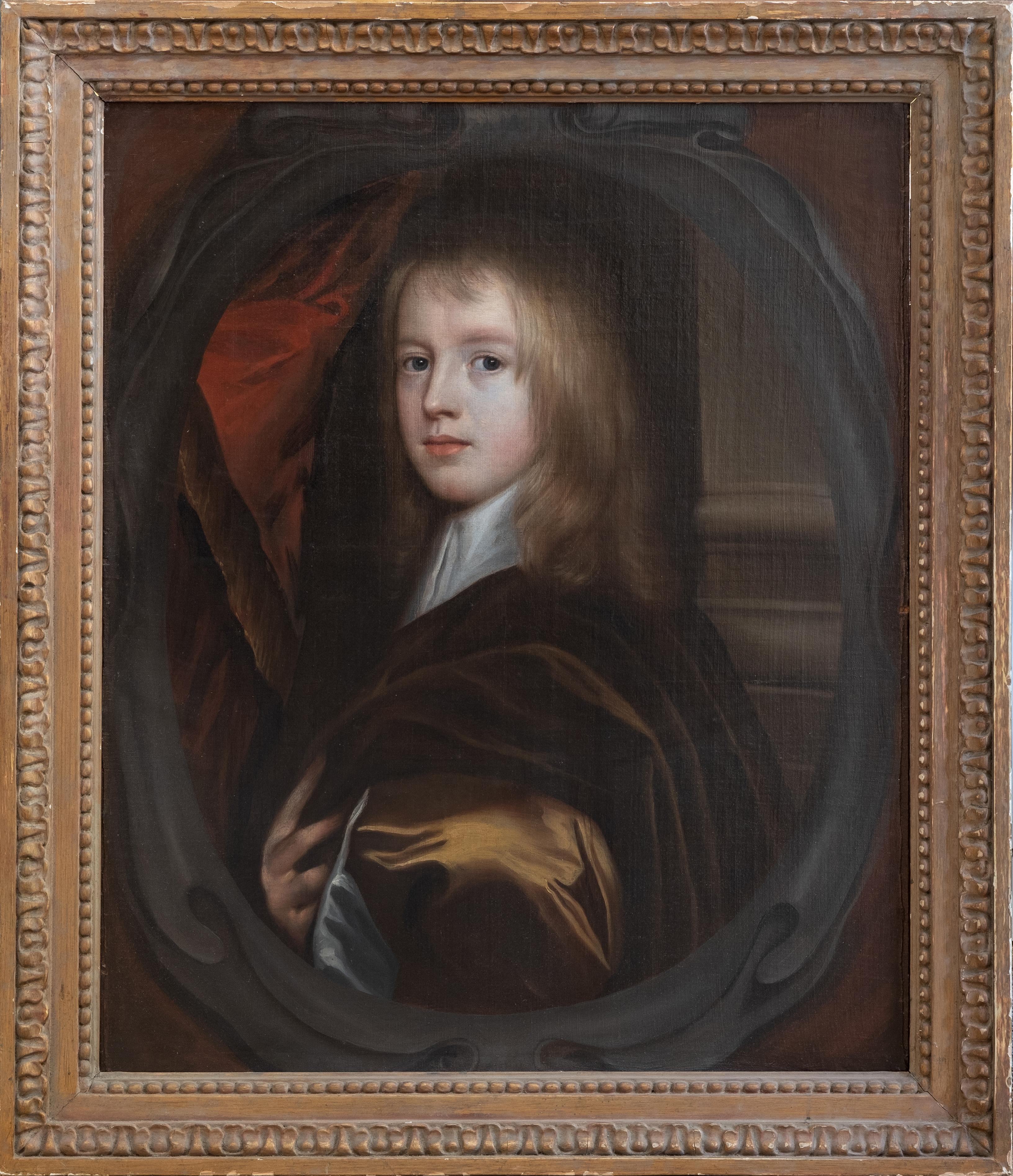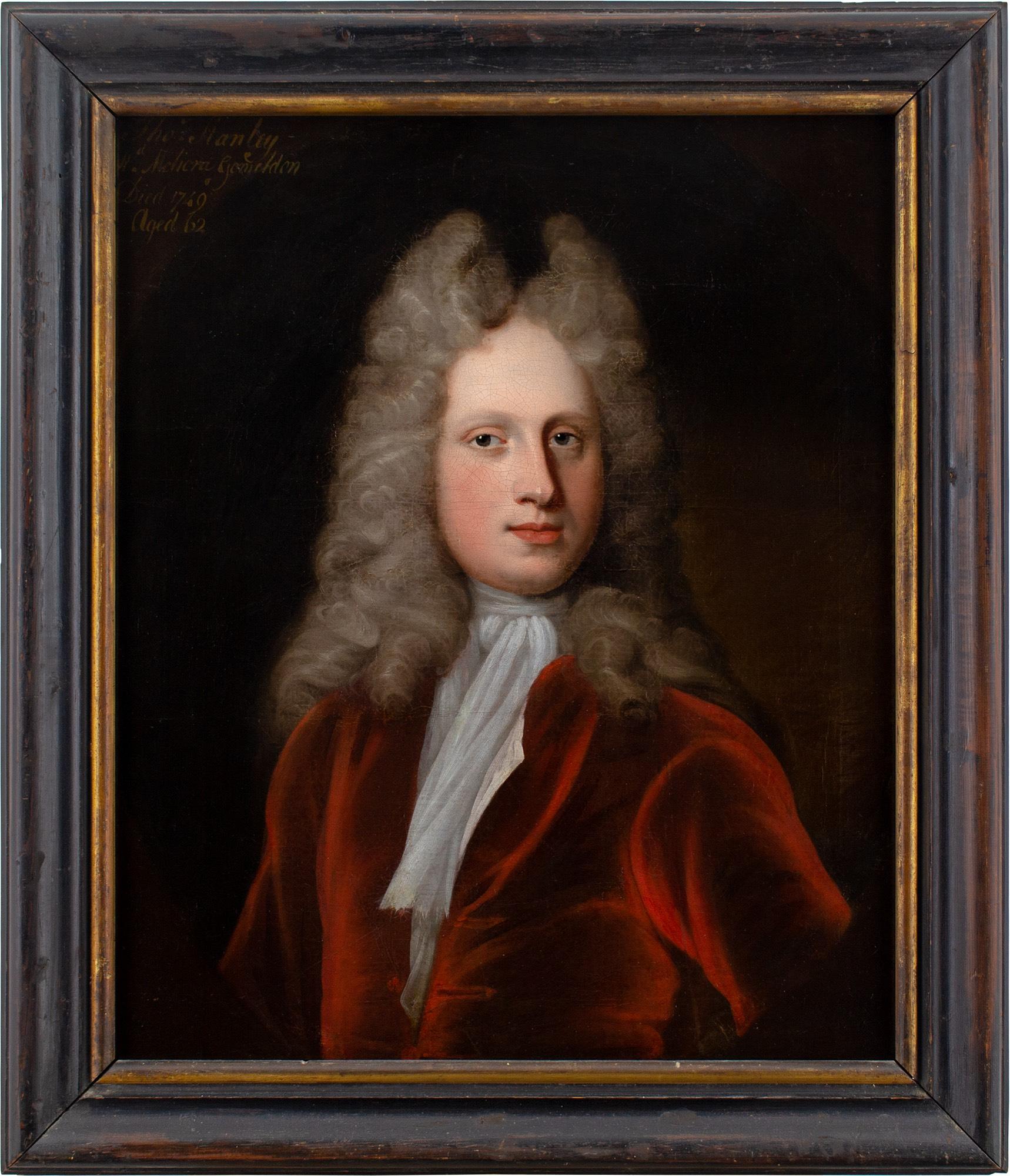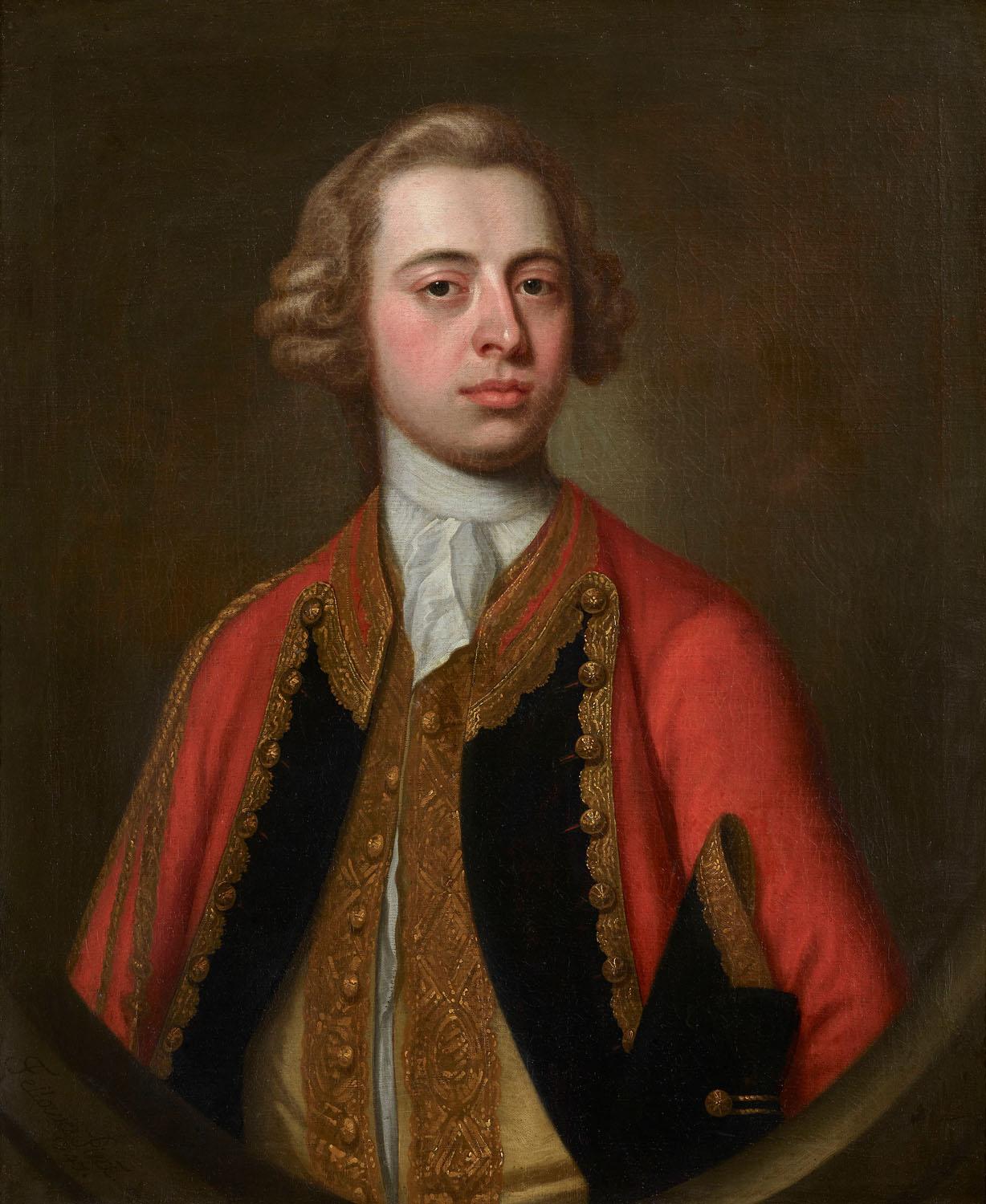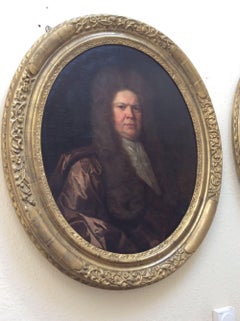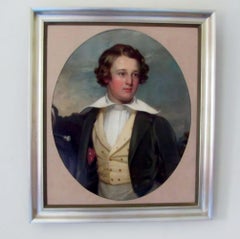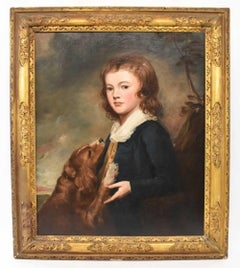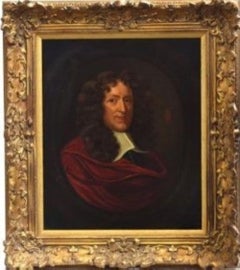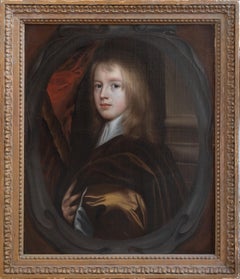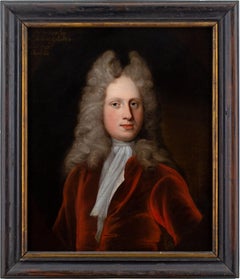Items Similar to ENOCH SEEMAN (circle of) PORTRAIT OF SIR FRANCIS SEYMOUR AS A BOY
Want more images or videos?
Request additional images or videos from the seller
1 of 5
ENOCH SEEMAN (circle of) PORTRAIT OF SIR FRANCIS SEYMOUR AS A BOY
$8,240.53
£5,995
€7,041.21
CA$11,493.15
A$12,449.92
CHF 6,555.39
MX$151,116.32
NOK 81,753.94
SEK 77,296.44
DKK 52,564.67
About the Item
ENOCH SEEMAN (circle of) PORTRAIT OF SIR FRANCIS SEYMOUR AS A BOY
A very fine 18th century portrait of Sir Francis Seymour as a boy,oil on canvas housed in a gilt frame, circle of Enoch Seeman
The size of the painting is 49 x 39.5cm (19¼ x 15½ in.) whilst overall the size is 65 cm x 56 cm
The painting is in very good condition, the Canvas has been relined, and recently cleaned.(unsigned)
Provenance: Anonymous sale, Christie's, 19 January 1945, lot 34 Anonymous sale, Crewkerne, Somerset, 24 April 2009, lot 1947
SIR FRANCIS SEYMOUR
Francis Seymour, 1st Baron Seymour of Trowbridge (c. 1590 – 12 July 1664), of Marlborough Castle and Savernake Park in Wiltshire, was an English politician who sat in the House of Commons at various times between 1621 and 1641 when he was raised to the peerage as Baron Seymour of Trowbridge. He supported the Royalist cause during the English Civil War.
In June 1611 he was accused of abetting the escape of his brother William Seymour and his wife Arabella Stuart, but protested his innocence. He was knighted by King James I at Royston on 23 October 1613. In 1612 was settled on him by his grandfather the manor of "Puriton with Downend" in Somerset, formerly one of the many possessions of his great-grandfather the 1st Duke of Somerset.
In June 1642, Seymour signed the declaration that the king had no intention of war. He followed the King to York, offering to raise twenty horse in his cause, and Parliament accordingly declared him a delinquent. In autumn 1642 he went with his brother, the Marquis of Hertford, into the Westcountry to organise the royalist forces and suppress the parliamentary militia. He crossed the Bristol Channel from Minehead to Glamorganshire on a similar errand in September. In December 1643 he signed the letter of the peers to the council in Scotland, protesting against the invitation sent by parliament to the Scots to invade England. Early in 1645 he was on the commission for the defence and government of Oxford and the adjacent counties. In February he was one of the commissioners appointed to treat at Uxbridge, and in May he was appointed Chancellor of the Duchy of Lancaster. He was at Oxford when it surrendered on 22 June. He was admitted to composition and his fine was fixed at £3,725 by the Committee for Compounding with Delinquents. He attended a council at Hampton Court on 7 October 1647, but took no part in politics during the Commonwealth and Protectorate periods.
Enoch Seeman the Younger (c. 1689 – April 1745)
was an English painter who was active during the first half of the Georgian era. He was born into a family of painters in Danzig.
His work is found in many museums and national trust properties.
- Dimensions:Height: 25.6 in (65 cm)Diameter: 22.05 in (56 cm)
- Medium:
- Movement & Style:
- Circle Of:Enoch Seeman (1694 - 1744, Polish)
- Period:
- Condition:
- Gallery Location:York, GB
- Reference Number:1stDibs: LU1800214046662
About the Seller
5.0
Vetted Professional Seller
Every seller passes strict standards for authenticity and reliability
Established in 1991
1stDibs seller since 2022
24 sales on 1stDibs
Typical response time: 15 hours
- ShippingRetrieving quote...Shipping from: York, United Kingdom
- Return Policy
Authenticity Guarantee
In the unlikely event there’s an issue with an item’s authenticity, contact us within 1 year for a full refund. DetailsMoney-Back Guarantee
If your item is not as described, is damaged in transit, or does not arrive, contact us within 7 days for a full refund. Details24-Hour Cancellation
You have a 24-hour grace period in which to reconsider your purchase, with no questions asked.Vetted Professional Sellers
Our world-class sellers must adhere to strict standards for service and quality, maintaining the integrity of our listings.Price-Match Guarantee
If you find that a seller listed the same item for a lower price elsewhere, we’ll match it.Trusted Global Delivery
Our best-in-class carrier network provides specialized shipping options worldwide, including custom delivery.More From This Seller
View AllMichael Dahl (circle) 17th century portrait of Sir William Cowper
By (Circle of) Michael Dahl
Located in York, GB
Portrait of Sir William Cowper [1639-1706] Circle of Michael Dahl. (unsigned)Oil painting on canvas
17th century oval, bust-length, with a long dark wig,...
Category
17th Century Old Masters Portrait Paintings
Materials
Oil
$5,182 Sale Price
35% Off
Free Shipping
19th century Portrait Of A Young Man, Oil, Circle Of Thomas Jones Barker
Located in York, GB
Portrait of a young man,
half length wearing a yellow waistcoat and holding a cane , Circle of Thomas Jones Barker (1815-1882),(unsigned)
Oil on canvas, h...
Category
19th Century Realist Portrait Paintings
Materials
Oil
GEORGE ROMNEY(after)19th century portrait The Hon.Reverend Anchitel Grey as a Bo
By George Romney
Located in York, GB
A fine painting after George Romney of The Hon.Reverend Anchitel Grey (1774 – 1833) as a Boy
The painting depicts a boy aged about ten, standing, turned to the left, gazing at the spectator, wearing a blue coat, and white linen collar, a spaniel with its paws on his chest. Shoulder length brown hair. Trees in the background on the right, distant horizon with cloudy sky on the left.
The sitter was the third son of George Harry Grey, 5th Earl of Stamford (1765-1845) and Lady Henrietta Cavendish-Bentinck (died 4th June 1827), daughter of the 2nd Duke of Portland...
Category
19th Century Old Masters Portrait Paintings
Materials
Oil
Mary Beale (circle) Portrait Painting of Sir John Pettus
By (Circle of) Mary Beale
Located in York, GB
A very fine oil on canvas of Sir John Pettus ,circle of Mary Beale 17th century
Wearing a red cloak and a black tunic with white collar. His coat of arms to the right.Unsigned
Housed in a gilt frame, the size overall being 85 x 74 cm whilst the painting is 76 x 63.5cm
In overall excellent condition.
There is a wealth of history about the sitter online , below is a brief resume
John Pettus
Sir John Pettus (1613–1690) was an English royalist, politician and natural philosopher. Pettus was an expert on metallurgy and became a deputy governor of the royal mines in England and Wales under Charles I and II. He is known for the first English translation of the work of the German metallurgist Lazarus Ercker.
Pettus’s grandfather was a wealthy Norwich merchant ,he purchased the manor of Rackheath in 1590 and represented the city in 1601 and 1604-10. Although a younger son, Pettus inherited the manors of Chediston and Wenhaston, He married well; but even before the Civil War most of his estate was mortgaged, and his wife’s expectations were never realized, owing to her father’s misfortunes as leader of the City Royalists. Pettus became a servant to Charles I, and took part in the farcical royalist attempt on Lowestoft in March 1643, but was exchanged after nearly a year in prison. It is unlikely that he resumed command of his regiment, such as it was, since he ‘continued inoffensive till the taking of Bristol’ by the New Model Army...
Category
17th Century Old Masters Portrait Paintings
Materials
Oil
18th century antique portrait Edmund Hoyle Circle of James Latham, Edmund Hoyle
Located in York, GB
18th century Bust portrait of a gentleman in a blue coat with gold buttons (Said to be Edmund Hoyle, inventor of Whist) oil on canvas
circle of James Latham. Housed in a gilt frame the size overall is 71 x 84 cm (28 x 33 inches approx) whilst the painting is
56 x 69 cm ( 22 x 27 inches approx) unsigned
The overall condition is very good having had some restoration. The painting has been relined, cleaned and re varnished.
There has been some strengthening/overpainting. There is a Rectangular patch repair along lower edge, centre, reverse approximately 5 x 7cm with associated retouching to front,all essentially done sympathetically.
some fine stable craquelure throughout. Some minor self coloured losses to frame. None of the above detracting from
a very attractive portrait.
Edmond Hoyle
Edmond Hoyle
English card game authority, "the Father of whist"
Born 1672 England Died 29 August 1769 (aged 96–97)
London, England
Edmond Hoyle (1672 – 29 August 1769)[1] was a writer best known for his works on the rules and play of card games. The phrase "according to Hoyle" came into the language as a reflection of his generally perceived authority on the subject
James Latham
James Latham was born in Thurles, County Tipperary, Ireland and possibly related to the family of Lathams of Meldrum and Ballysheehan. After some practice of his art, Latham studied for an academic year in Antwerp (1724–25) where he became a Master of the Guild of St Luke. He returned to Dublin by 1725, and may have visited England in the 1740s, as the influence of Joseph Highmore, as well as Charles Jervas and William Hogarth, is evident in his work of this period. Anthony Pasquin memorably dubbed Latham "Ireland's Van Dyck". Latham died in Dublin on 26 January 1747.
Several of James Latham's portraits are in the National Gallery of Ireland collection in Dublin; one is of the famous MP Charles Tottenham (1694–1758) of New Ross, Co. Wexford, "Tottenham in his Boots" (Cat. No.411) and a second is a portrait of Bishop...
Category
Mid-18th Century Old Masters Portrait Paintings
Materials
Oil
$3,848 Sale Price
20% Off
Free Shipping
19th Century Portrait, Child At Play , Attributed To Henry Tanworth Wells
Located in York, GB
19th century portrait, child at play ,Attributed to Henry Tanworth Wells( unsigned)
A beautiful oval portrait of a young child at play, attributed to the portrait painter Henry Tanworth Wells.
finely executed, this oil on canvas is in excellent condition. Housed in a period frame.
The size overall is 79 cm x 62 cm whilst the painting is 56 cm x 46 cm
Henry Tanworth Wells [1828-1903]
Henry Tanworth Wells RA was an English miniature and portrait painter. He was a member of the Pre-Raphaelite circle though he painted in the academic style. His most popular painting...
Category
19th Century Old Masters Portrait Paintings
Materials
Oil
You May Also Like
17th Century Oil Painting Portrait of a Young English Boy
By Gerard Soest
Located in London, GB
Gerard SOEST (1600 - 1681)
Portrait of a Young Boy
oil on canvas
35.5 x 30.5 inches inc. frame
Gerard Soest (circa 1600 – 11 February 1681), also known as Gerald Soest, was a portra...
Category
17th Century Old Masters Portrait Paintings
Materials
Oil
Portrait of a Young Boy - British art 1780 Old Master male portrait oil painting
By Joseph Wright of Derby
Located in Hagley, England
This lovely Old Master portrait oil painting is attributed to the circle of Joseph Wright of Derby. Painted circa 1780 the painting is of a boy in a tunic and wide collar. A really c...
Category
18th Century Old Masters Portrait Paintings
Materials
Oil
$8,522 Sale Price
20% Off
Portrait of William Herbert, 3rd Earl of Pembroke, Early 17th Century Portrait
Located in London, GB
English School, (circa 1600)
Portrait of William Herbert, 3rd Earl of Pembroke
Oil on panel, oval
Image size: 29¼ x 23⅞ inches
Painted wooden frame
Provenance:
176, Collection of Francis Greville, 1st Earl of Warwick.
The Trustees of the Lord Brooks’ Settlement, (removed from Warwick Castle).
Sotheby’s, London, 22nd March 1968, lot 81.
Painted onto wooden panel, this portrait shows a dark haired gentleman in profile sporting an open white shirt. On top of this garments is a richly detailed black cloak, decorated with gold thread and lined with a sumptuous crimson lining. With the red silk inside it’s all very expensive and would fall under sumptuary laws – so this is a nobleman of high degree.
It’s melancholic air conforms to the contemporary popularity of this very human condition, evident in fashionable poetry and music of the period. In comparison to our own modern prejudices, melancholy was associated with creativity in this period.
This portrait appeared in the earliest described list of pictures of Warwick castle dating to 1762. Compiled by collector and antiquary Sir William Musgrave ‘taken from the information of Lord & Lady Warwick’ (Add. MSS, 5726 fol. 3) is described;
‘8. Earl of Essex – an original by Zuccharo – seen in profile with black hair. Holding a black robe across his breast with his right hand.’
As tempting as it is to imagine that this is a portrait of Robert Devereux, the 2nd Earl Essex, we might take this with a pinch of salt. Its identification with this romantic and fatal Elizabethan might well have been an attempt to add romance to Warwick Castle’s walls. It doesn’t correspond all that well with Essex’s portraits around 1600 after his return from Cadiz. Notably, this picture was presumably hung not too far away from the castle’s two portraits of Queen Elizabeth I. The first, and undoubtedly the best, being the exquisite coronation portrait that was sold by Lord Brooke in the late 1970s and now hangs in the National Portrait Gallery. The second, described as being ‘a copy from the original at Ld Hydes’, has yet to resurface.
The portrait eventually ended up being hung in the State Bedroom of Warwick Castle.
Archival documents present one other interesting candidate. The Greville family’s earliest inventory of paintings, made in 1630 at their home Brooke House in Holborn, London, describes five portraits of identified figures. All five belonged to the courtier, politician and poet Sir Fulke Greville (1554-1628), 1st Baron Brooke, and were hung in the ‘Gallerie’ of Brooke House behind yellow curtains. One of them was described as being of ‘Lord of Pembrooke’, which is likely to have been William Herbert (1580-1630), 3rd Earl of Pembroke. William was the eldest son of Greville’s best friend’s sister Mary Sidney, and was brought up in the particularly literary and poetically orientated household which his mother had supported. Notably, the 3rd Earl was one of the figures that Shakespeare’s first folio was dedicated to in 1623.
The melancholic air to the portrait corresponds to William’s own pretensions as a learned and poetic figure. The richness of the robe in the painting, sporting golden thread and a spotted black fabric, is indicative of wealth beyond that of a simple poet or actor. The portrait’s dating to around the year 1600 might have coincided with William’s father death and his own rise to the Pembroke Earldom. This period of his life too was imbued with personal sadness, as an illicit affair with a Mary Fitton had resulted in a pregnancy and eventual banishment by Elizabeth I to Wilton after a short spell in Fleet Prison. His illegitimate son died shortly after being born. Despite being a close follower of the Earl of Essex, William had side-stepped supporting Devereux in the fatal uprising against the Queen and eventually regained favour at the court of the next monarch James I.
His linen shirt is edged with a delicate border of lace and his black cloak is lined on the inside with sumptuous scarlet and richly decorated on the outside with gold braid and a pattern of embroidered black spots.
Despite the richness of his clothes, William Herbert has been presented in a dishevelled state of semi-undress, his shirt unlaced far down his chest with the ties lying limply over his hand, indicating that he is in a state of distracted detachment. It has been suggested that the fashion for melancholy was rooted in an increase in self-consciousness and introspective reflection during the late 16th and early 17th centuries.
In contemporary literature melancholy was said to be caused by a plenitude of the melancholy humor, one of the four vital humors, which were thought to regulate the functions of the body. An abundance of the melancholia humor was associated with a heightened creativity and intellectual ability and hence melancholy was linked to the notion of genius, as reflected in the work of the Oxford scholar Robert Burton, who in his work ‘The Anatomy of Melancholy’, described the Malcontent as ‘of all others [the]… most witty, [who] causeth many times divine ravishment, and a kind of enthusiamus… which stirreth them up to be excellent Philosophers, Poets and Prophets.’ (R. Burton, The Anatomy of Melancholy, London, 1621 in R. Strong, ‘Elizabethan Malady: Melancholy in Elizabethan and Jacobean Portraits’, Apollo, LXXIX, 1964).
Melancholy was viewed as a highly fashionable affliction under Elizabeth I, and her successor James I, and a dejected demeanour was adopted by wealthy young men, often presenting themselves as scholars or despondent lovers, as reflected in the portraiture and literature from this period. Although the sitter in this portrait is, as yet, unidentified, it seems probable that he was a nobleman with literary or artistic ambitions, following in the same vain as such famous figures as the aristocratic poet and dramatist, Edward de Vere...
Category
Early 17th Century Old Masters Portrait Paintings
Materials
Oil, Wood Panel
Michael Dahl (Circle), Portrait Of Thomas Stanley
Located in Cheltenham, GB
This early 18th-century English School portrait depicts Thomas Stanley wearing a striking red velvet suit, white cravat and powdered periwig. Fashionable, yet elegantly refined. On t...
Category
Early 18th Century English School Portrait Paintings
Materials
Canvas, Oil
Portrait of William Henry Kerr, Earl of Ancram, 4th Marquess of Lothian
Located in London, GB
James Fellowes
Flourished 1719 - 1750
Portrait of William Henry Kerr, Earl of Ancram, 4th Marquess of Lothian
Oil on canvas, signed & dated 1747
Image size: 29 1/2 x 24 1/2 inches (75 x 62 cm)
Original gilt wood frame
William Henry Kerr was born a member of the Scottish peerage to William, third Marquess of Lothian, and his first wife Margaret, daughter of Sir Thomas Nicholson of Kemnay, first Baronet. William was styled Master Jedburgh until 1722, when his father was elevated to a Marquessate, after which he was referred to as Lord Jedburgh until 1735. Following his father’s military footsteps, on 20 June 1735 Ancram was commissioned as a cornet to the regiment (11th Dragoons) of his grand-uncle, Lord Mark Kerr. Ancram married Lady Caroline...
Category
1740s Old Masters Portrait Paintings
Materials
Oil
Portrait Young Boy Lombard School 17th Century Paint Oil on canvas Old master
Located in Riva del Garda, IT
Lombard School, 17th century
Portrait of a Young Boy
oil on canvas
109 x 78 cm - 127 x 97 cm with frame
The protagonist of the offered canvas is a chubby little boy, aged approxima...
Category
17th Century Old Masters Paintings
Materials
Oil
$9,311 Sale Price
20% Off
More Ways To Browse
Seymour Antique
Hampton Court
King James I
English Civil War
Enoch Seeman
Duke Of Somerset
Sir Anthony Van Dyck
17 Century Portraits
17th Century Man Portrait
African American Portrait Painting
Coronation Painting
Danse Macabre
Military Portrait Paintings
Native American Portraits
Painting Of African Woman
Woman Portrait Black Dress
1944 Portraits
Middle Temple
